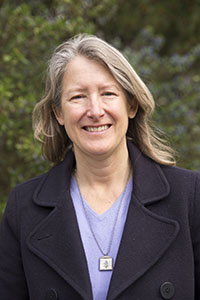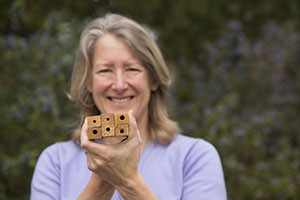Biologist launches 'Great Pollinator Habitat Challenge'
With the help of more than 100,000 volunteers nationwide, Gretchen LeBuhn's Great Sunflower Project has built the single largest database of North American pollinator populations. Now, the San Francisco State University biologist is taking the project a step further, launching an effort to help those "citizen scientists" make their backyards or local parks more pollinator friendly.

Professor of Biology Gretchen LeBuhn, who since 2008 has led the Great Sunflower Project, has now launched the Great Pollinator Habitat Challenge, aimed at making backyards and local parks more bee-friendly.
In the process, the Great Pollinator Habitat Challenge will provide researchers with crucial data about which habitat improvements, such as planting native wildflowers or creating habitat corridors, are most effective at attracting bees and other pollinators. That data will in turn aid conservationists in their efforts to stem an alarming decline in pollinator populations.
"This is one of the few citizen science projects that engages the public in the full cycle of conservation, from data collection to taking action," said LeBuhn, a professor of biology. "As the dataset is built, it will become more and more useful to the community. When we think about our limited conservation dollars, we want to make sure we're doing what works best."
Begun in 2008, The Great Sunflower Project asks participants to monitor backyard flowers -- initially a sunflower but later expanded to include all other plants -- and count the number of bees that visit it, helping researchers see where pollinators are thriving and where they are struggling. When volunteers began to ask how they could make their habitats more pollinator friendly, LeBuhn realized she had an opportunity to provide her citizen science volunteers with resources for improving habitat.
"Unfortunately, we are lacking data to guide such efforts. Not only were we not providing them with resources to improve habitats, I discovered that we as researchers don't really have data on what interventions actually work," she said.

Bee nesting sites, shown above by LeBuhn, are one way participants can make their garden friendlier to pollinators.
The Great Pollinator Habitat Challenge will track the ways in which participants improve their habitats and compare the number of pollinator visits from year to year. An online questionnaire will evaluate a volunteer's habitat and offer personalized suggestions for how to attract more pollinators. As participants submit their results via the website, researchers will learn which methods are effective and which are not.
Beyond acquiring data, however, LeBuhn says another major goal of the project is to increase the amount of space available for pollinators, and that even small contributions can make a big difference.
"Let's say you had 1,000 people in San Francisco participate, and they all improved a quarter of an acre. That means we're getting 250 acres of new pollinator habitat," she said. "These small patches can make a big difference."
To learn more about the Great Sunflower Project, including how to sign up for the Great Pollinator Habitat Challenge, visit http://www.greatsunflower.org